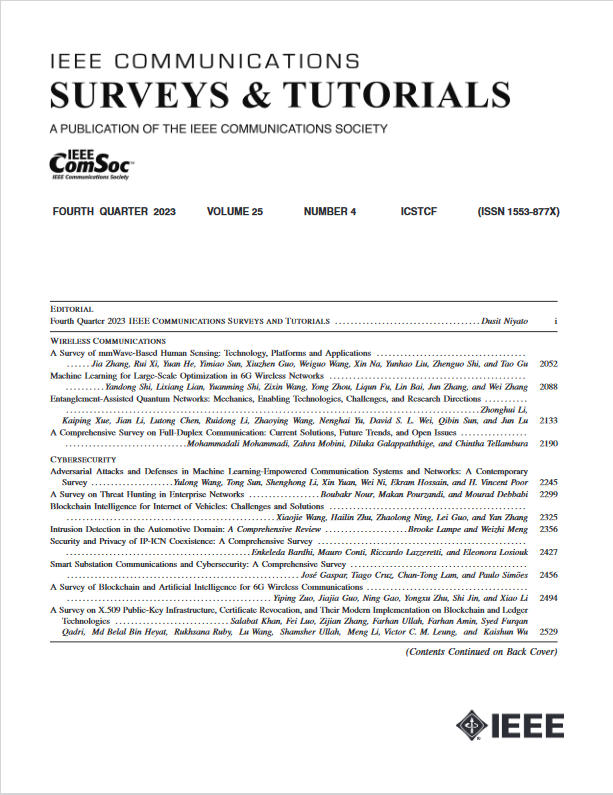网络钓鱼网页检测:揭开威胁面纱,探究检测技术
IF 34.4
1区 计算机科学
Q1 COMPUTER SCIENCE, INFORMATION SYSTEMS
引用次数: 0
摘要
在网络安全领域,网络钓鱼是一种普遍的网络攻击,攻击者采用各种策略欺骗用户收集他们的敏感信息,可能导致身份盗窃或经济利益。研究人员一直在积极致力于推进网络钓鱼网页检测方法,以检测新的网络钓鱼url,加强用户保护。尽管如此,攻击者所采用的不断发展的策略,旨在绕过现有的检测方法和工具,给研究界带来了持续的挑战。本调查对各种网络钓鱼网页检测方法进行了系统分类,包括基于url的、基于网页内容的、基于第三方的和可视化的技术。通过对这些方法的全面回顾和对现有文献的深入分析,我们的研究强调了当前在网络钓鱼网页检测方面的研究差距。此外,我们提出了一些潜在的解决方案来解决这些差距,为正在进行的打击网络钓鱼攻击的努力提供有价值的见解。本文章由计算机程序翻译,如有差异,请以英文原文为准。
Phishing Webpage Detection: Unveiling the Threat Landscape and Investigating Detection Techniques
In the realm of cybersecurity, phishing stands as a prevalent cyber attack, where attackers employ various tactics to deceive users into gathering their sensitive information, potentially leading to identity theft or financial gain. Researchers have been actively working on advancing phishing webpage detection approaches to detect new phishing URLs, bolstering user protection. Nonetheless, the ever-evolving strategies employed by attackers, aimed at circumventing existing detection approaches and tools, present an ongoing challenge to the research community. This survey presents a systematic categorization of diverse phishing webpage detection approaches, encompassing URL-based, webpage content-based, third-party-based and visual techniques. Through a comprehensive review of these approaches and an in-depth analysis of existing literature, our study underscores current research gaps in phishing webpage detection. Furthermore, we suggest potential solutions to address some of these gaps, contributing valuable insights to the ongoing efforts to combat phishing attacks.
求助全文
通过发布文献求助,成功后即可免费获取论文全文。
去求助
来源期刊

IEEE Communications Surveys and Tutorials
COMPUTER SCIENCE, INFORMATION SYSTEMS-TELECOMMUNICATIONS
CiteScore
80.20
自引率
2.50%
发文量
84
审稿时长
6 months
期刊介绍:
IEEE Communications Surveys & Tutorials is an online journal published by the IEEE Communications Society for tutorials and surveys covering all aspects of the communications field. Telecommunications technology is progressing at a rapid pace, and the IEEE Communications Society is committed to providing researchers and other professionals the information and tools to stay abreast. IEEE Communications Surveys and Tutorials focuses on integrating and adding understanding to the existing literature on communications, putting results in context. Whether searching for in-depth information about a familiar area or an introduction into a new area, IEEE Communications Surveys & Tutorials aims to be the premier source of peer-reviewed, comprehensive tutorials and surveys, and pointers to further sources. IEEE Communications Surveys & Tutorials publishes only articles exclusively written for IEEE Communications Surveys & Tutorials and go through a rigorous review process before their publication in the quarterly issues.
A tutorial article in the IEEE Communications Surveys & Tutorials should be designed to help the reader to become familiar with and learn something specific about a chosen topic. In contrast, the term survey, as applied here, is defined to mean a survey of the literature. A survey article in IEEE Communications Surveys & Tutorials should provide a comprehensive review of developments in a selected area, covering its development from its inception to its current state and beyond, and illustrating its development through liberal citations from the literature. Both tutorials and surveys should be tutorial in nature and should be written in a style comprehensible to readers outside the specialty of the article.
 求助内容:
求助内容: 应助结果提醒方式:
应助结果提醒方式:


